Simplicity is one of the principles that most coaches and analysts look for in their set-piece routine, especially at the beginning of accepting the job of leading a new club. Open-play tactics can take time for the players to adapt properly, so coaches rely on set pieces to achieve good results and help them to continue in their jobs.
Yet, even in the realm of set pieces, simplicity is a strategic choice. It takes time for players to adapt to complex routines with specific roles, tailored to their abilities and the defending team’s scheme. This strategic approach, not just a collection of ideas, is what sets successful coaches and analysts apart.
In this case, coaches and analysts rely on simple tactics but are also highly effective. In this tactical analysis, we will dissect one of them which is targeting a close area, near the penalty spot, with a direct grounded pass from the taker into the ‘flat passing lane‘, and how this could be implemented against different defending schemes. Ultimately, we will explain how elite teams defend against this idea with a simple trick.
The beginning of the story
You may watch this scene below many times every game you watch, with the short-option defender standing to be ready for the probable short corner, but did you ask yourself about this defender’s reference to standing at this point, not at points 1, 2, or 3, as many teams do?
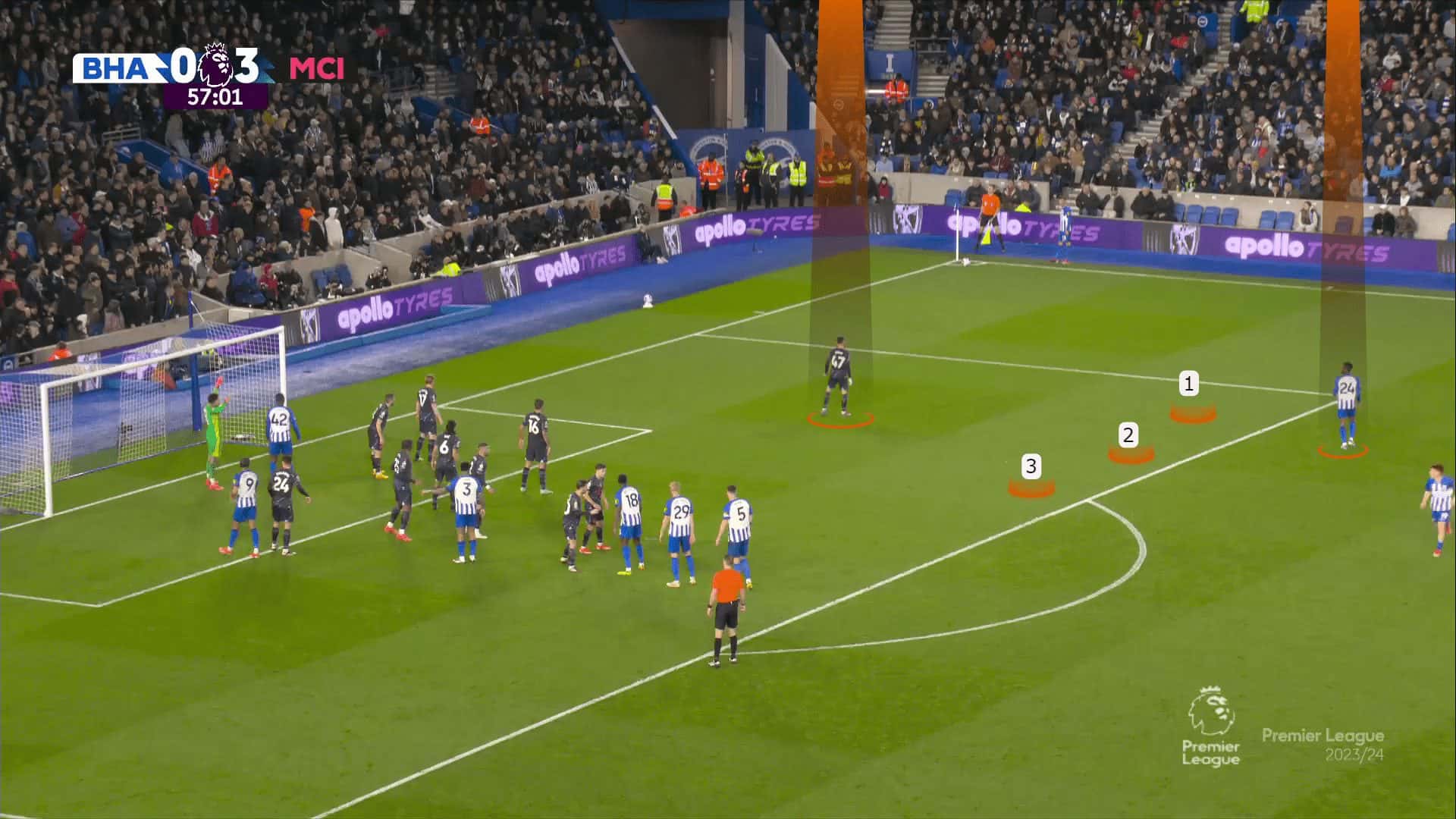
To answer that question, we need to step back and look at the traditional routines that used to pass the ball to a good shooter to kick the ball into the net. Most of these routines were about exploiting that the defending teams give priority to defending the box, leaving the edge of the box empty, so attacking teams tried to send direct passes, or chipped passes, directly to the edge of the box. This also can happen in several ways to drag the rebound defender away, as in the cases below.
Here, the opponent defends with a man-marking defending system with only two zonal players, which means that the attacking team can control the markers’ movement far away from the rebound zone, so you can see the attackers standing on the far post dragging the markers far from the rebound zone and the near-post zone where they intend to shoot the ball. There is a player who initially stands in the rebound zone to move towards the taker to drag the defender with him for a player who started at the back.
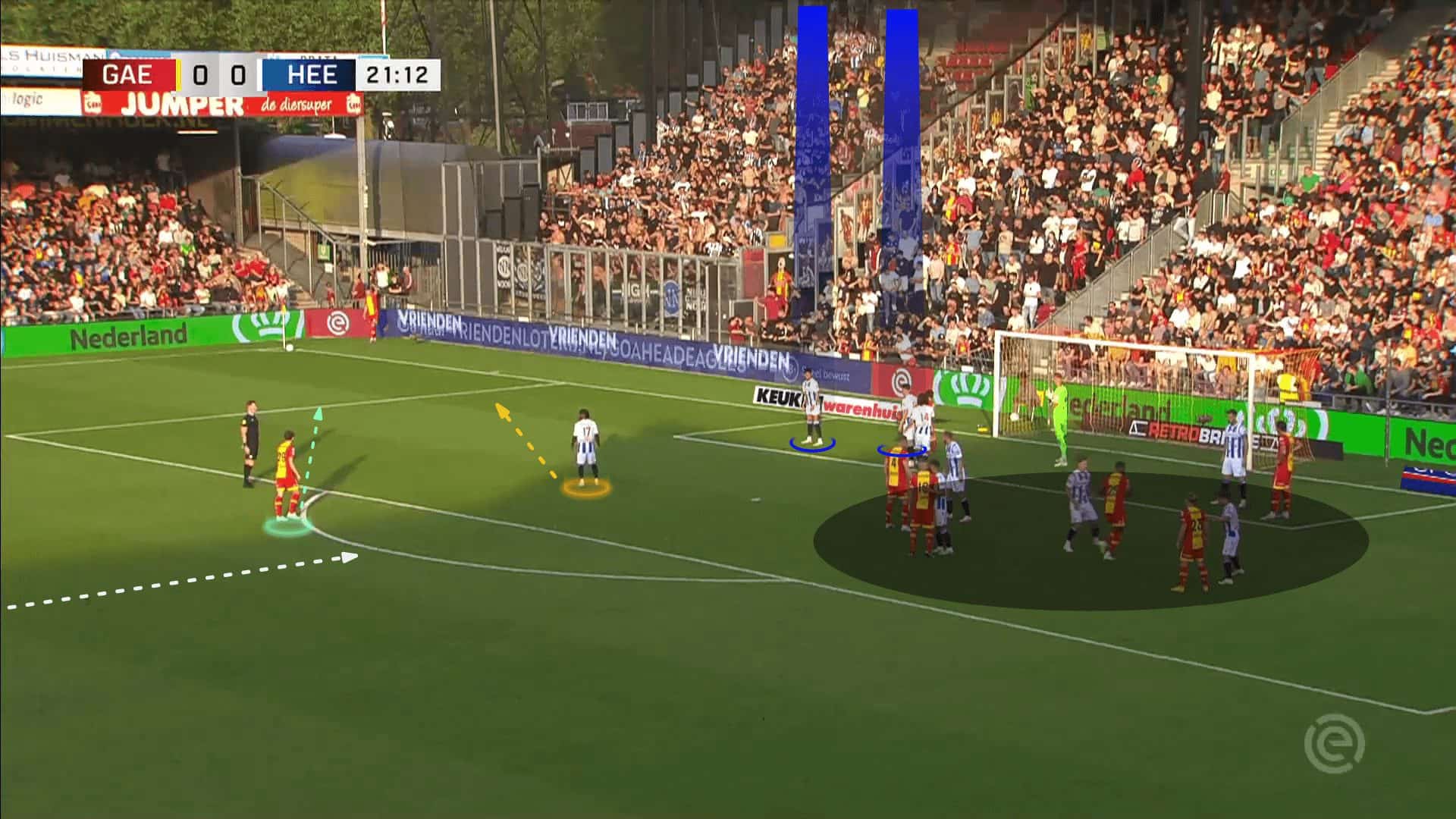
The blue attacker returned instead of the targeted player to secure the counter-attacks. In contrast, the rest of the attackers moved forward, dragging their markers and blocking anyone trying to go to the rebound zone except an attacker who was still standing on the far post for the rebound from the goalkeeper if it happened.
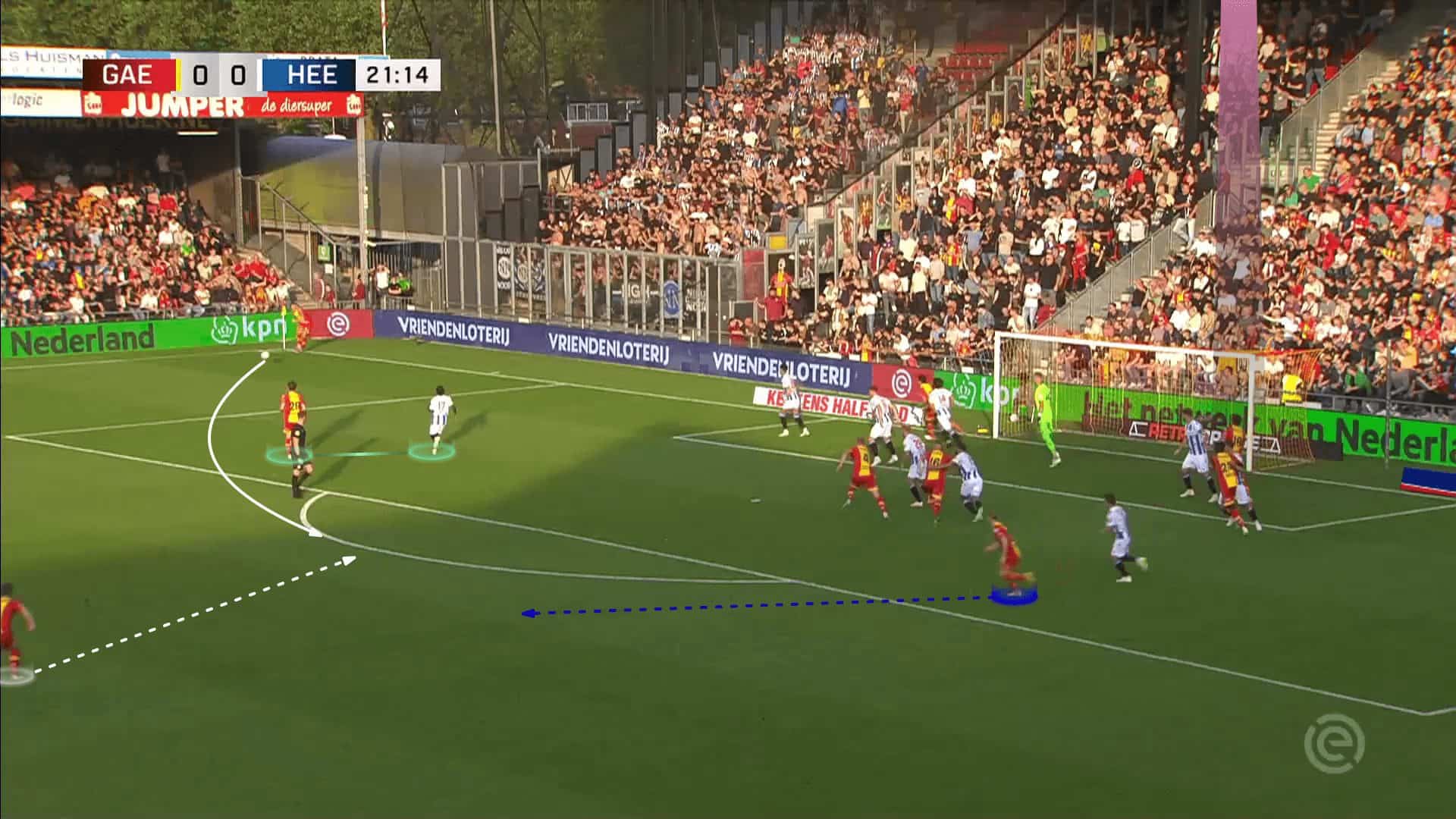
Now, the plan works, so the targeted player gets the ball easily on the rebound zone while there are players framing the ball to be ready for the rebound, and the result is a goal, as shown in the two following photos.

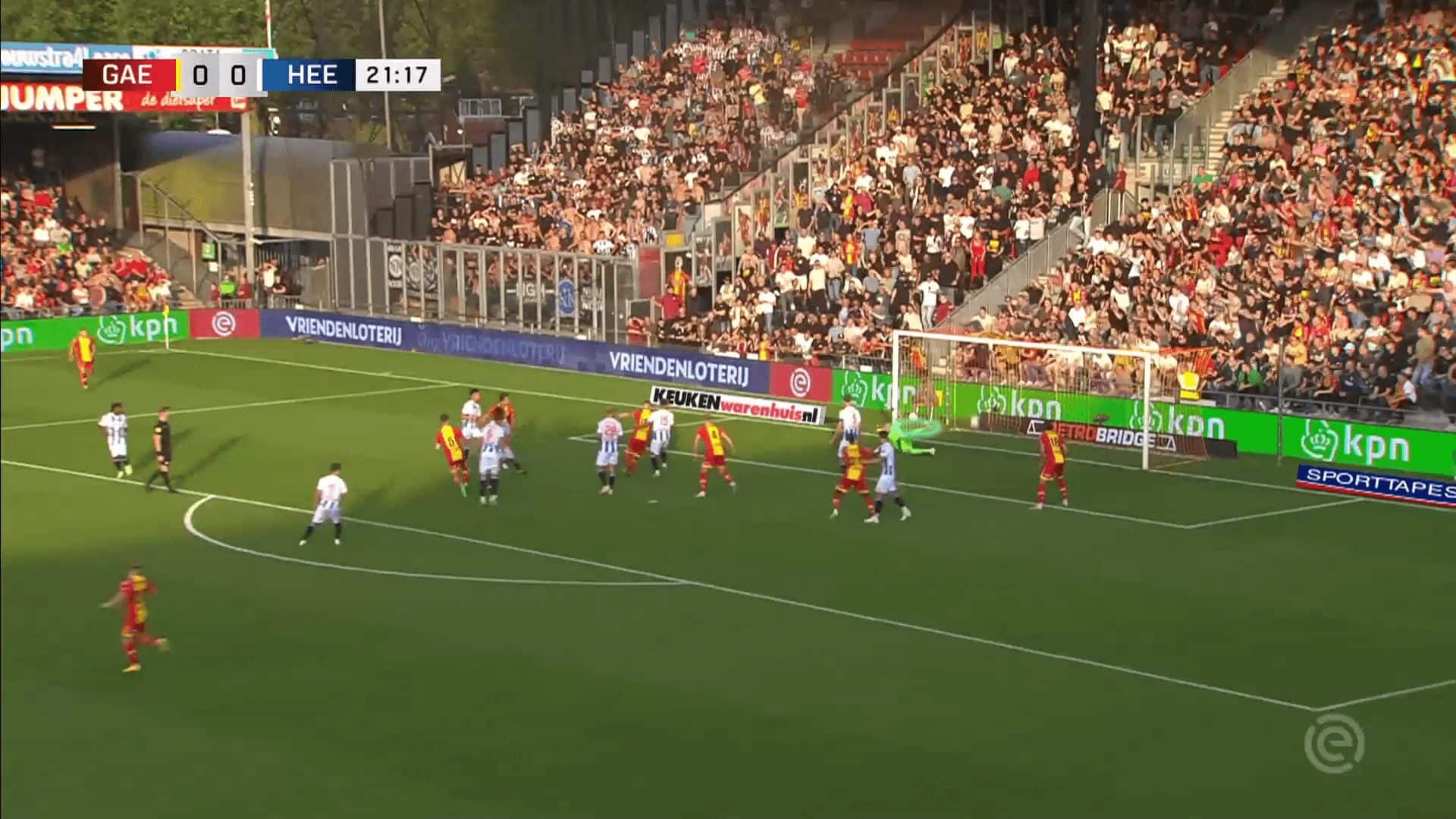
Here, we want to highlight again the double role of the attackers who block the defender at first to prevent them from getting out to the rebound zone. Then, they stand framing the goal to get any inaccurate ball, so you can see that the shot from that distance is too challenging to be a goal many times, so they do this action to increase the possibility of converting the shot to a goal. In the fourth photo, this highlighted attacker receives the inaccurate shot and shoots it to be a goal.
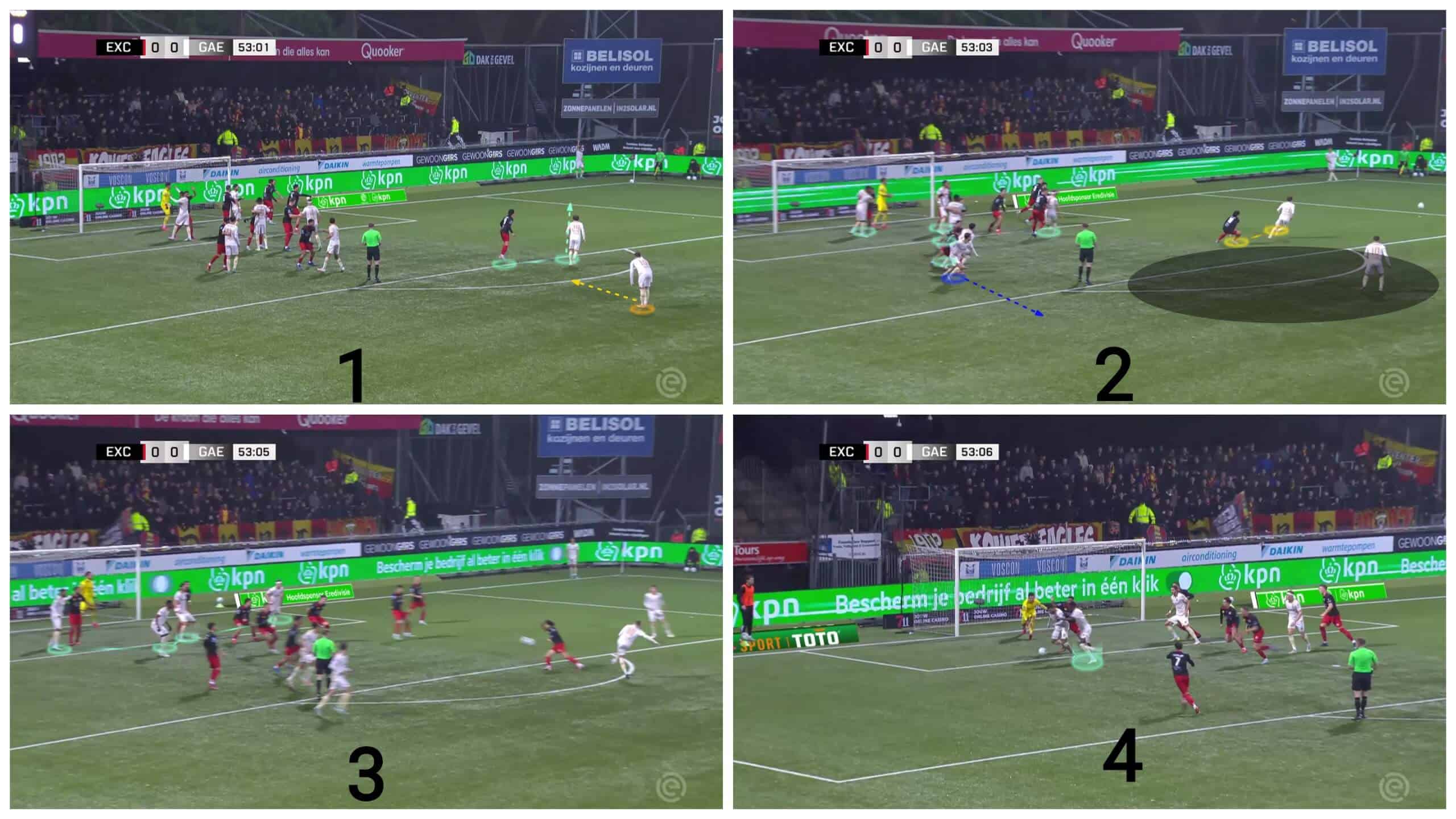
In the photo below, the defending team system is clear by using five zonal defenders on the first zonal line, a zonal defender in front of them to defend flicks and go to help in case of short corners, three man markers and only a player to defend the edge of the box, so he can be easily dragged to the short area to target the rebound zone directly. Here, we should mention that the opponent’s starting with many players a little in far positions between the penalty spot and the edge of the box is a trigger for them to dispense with the rebound defender to increase the blockers.
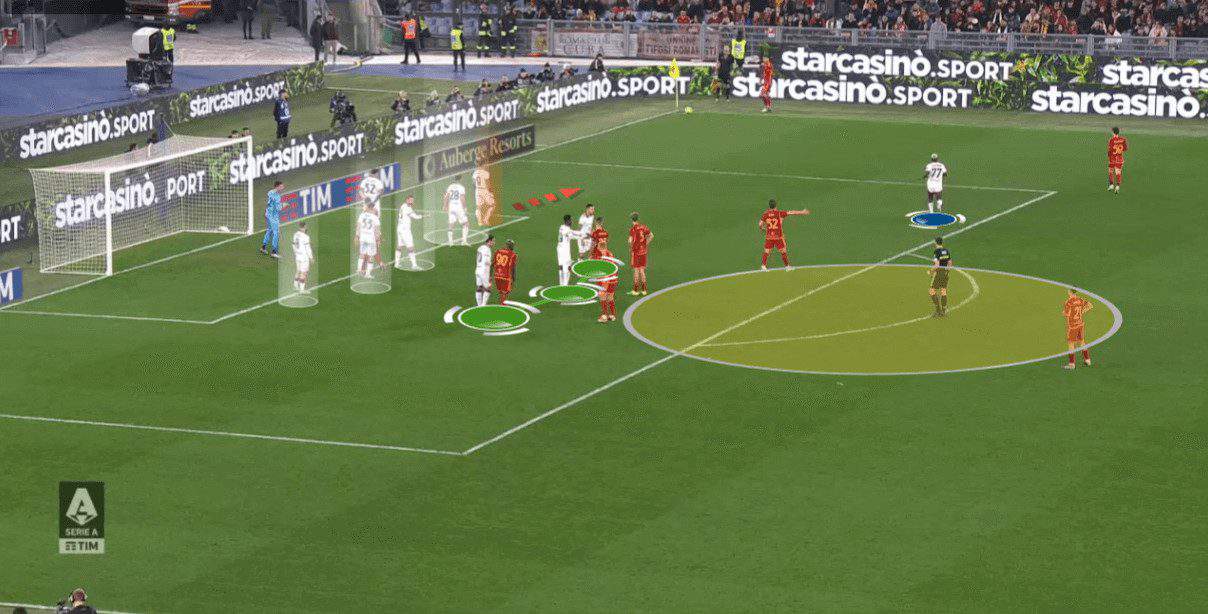
As shown in the photo below, the taker crosses the ball directly toward the rebound zone, where an attacker can shoot it directly.
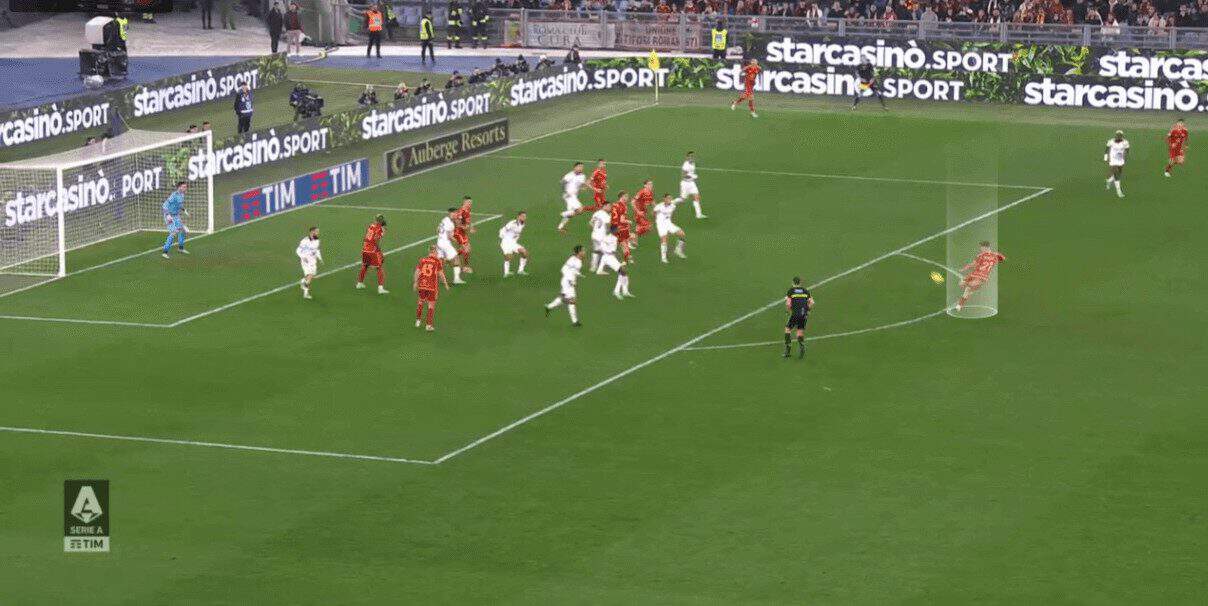
The easy flat-passing-lane routine against man-marking
It’s clear that the previous traditional ways have little possibility of being a goal because of the traffic in front of the kick, so it may hit a defender and the long time the ass, or the cross, takes to reach the edge of the box, so any defender can realise the idea and go to clear the ball. These ideas also need a great shooter to score from this distance, but the previous routines dealt with that. The real problem happens when teams decide to fix a zonal defender to defend the edge of the box, given instructions not to be dragged away by any attacker trying to do that, so another easier routine can be used in an easier and more effective way. Let’s explain in detail!
When you face a man-marking defending system, you are the leader who controls the movement of the defender, so it is easy to empty all of this passing lane by asking the attackers to stand on the far post while also asking three attackers to stand around the short and rebound areas to take the attention of the short-option and rebound defenders. Hence, the pass is possible, as shown below.
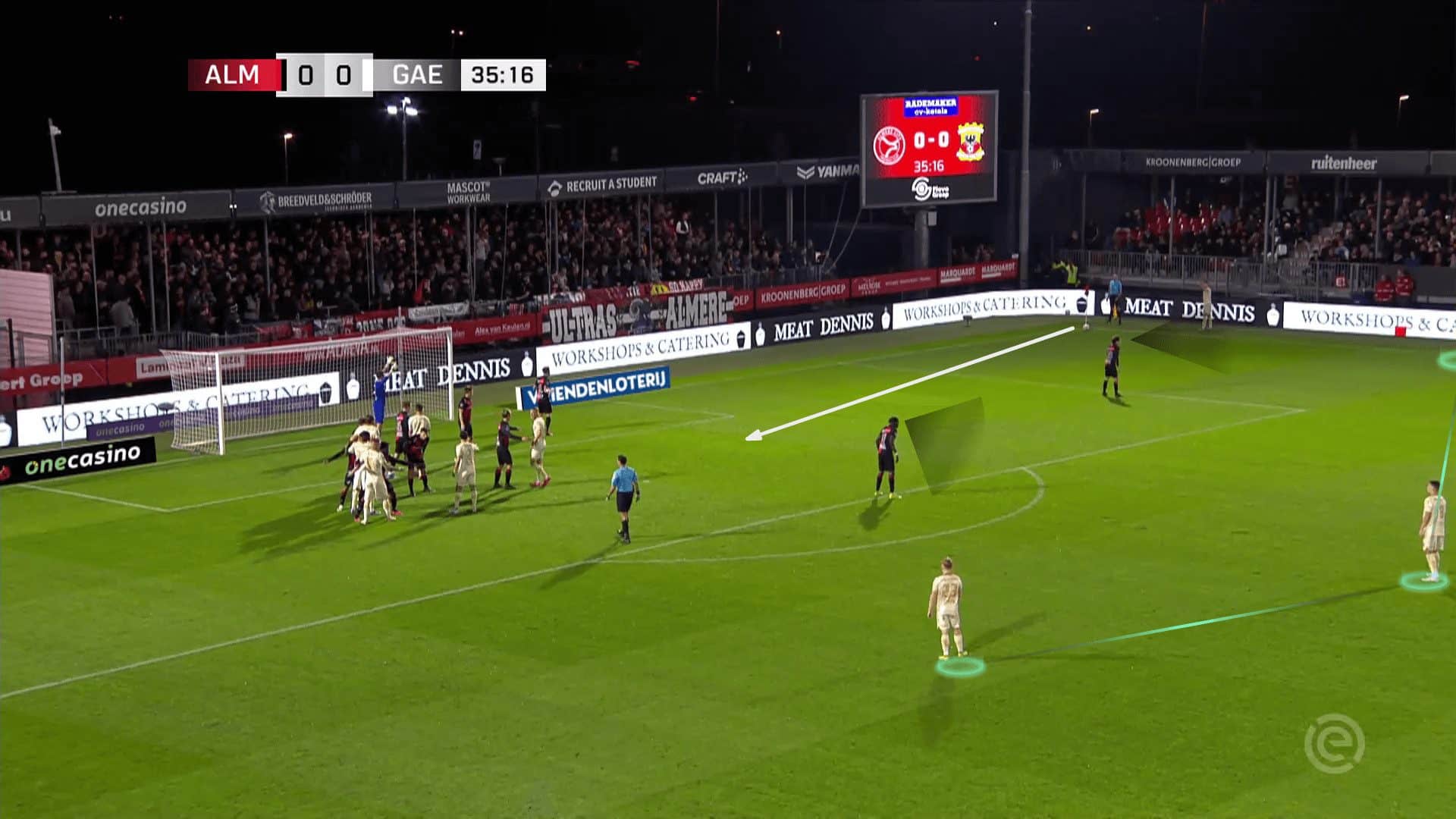
Now, they have only two problems: the two zonal defenders, in red, and how to get rid of the marker of the targeted player, in blue. First, with their markers, two attackers, in yellow and green, go to the two zonal players to take their attention, trying to block them to prevent them from getting the ground direct pass.
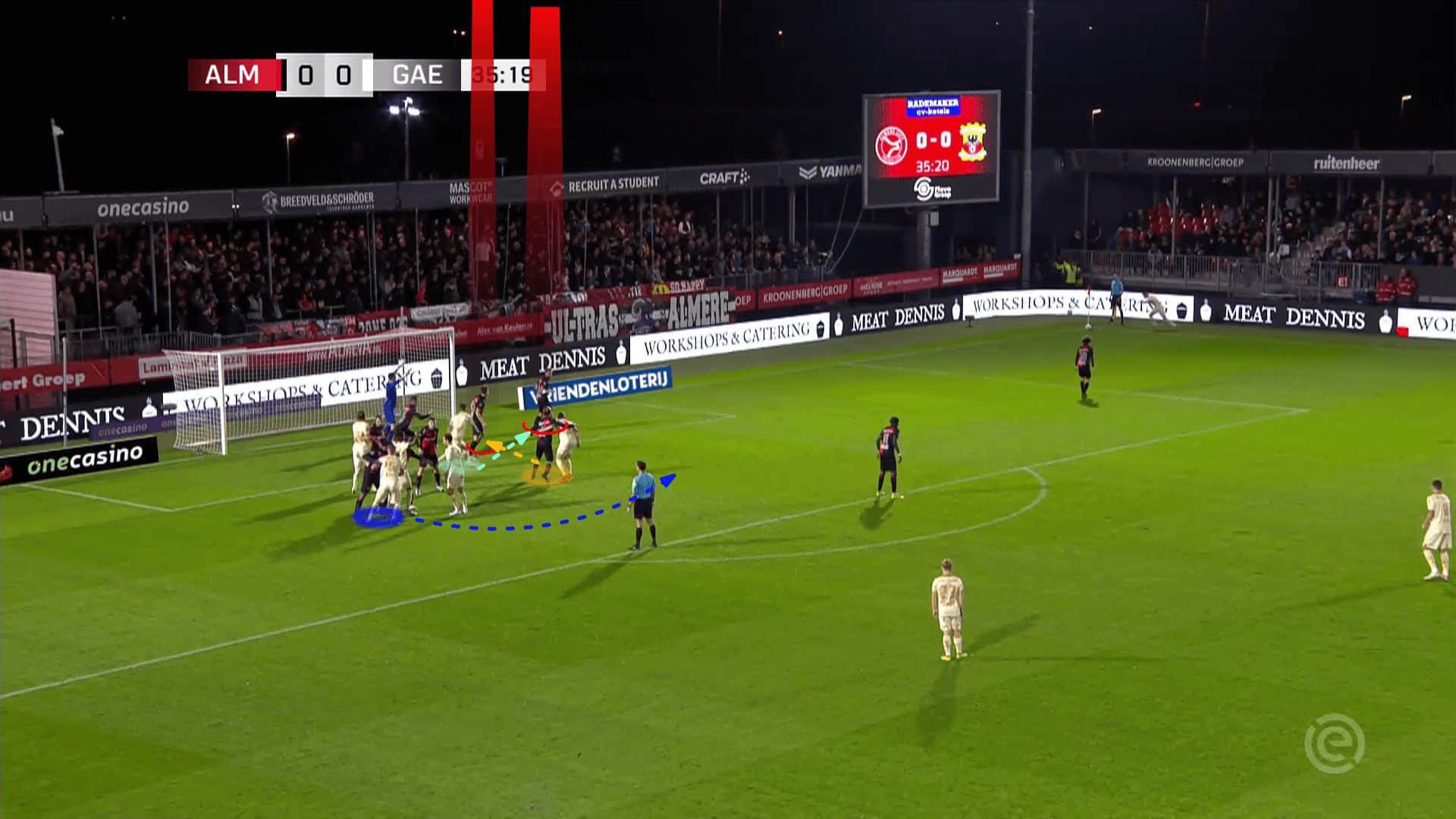
In the second part of the plan, they use another attacker to act as a screen, running towards the targeted player’s marker to block him to free the targeted player.
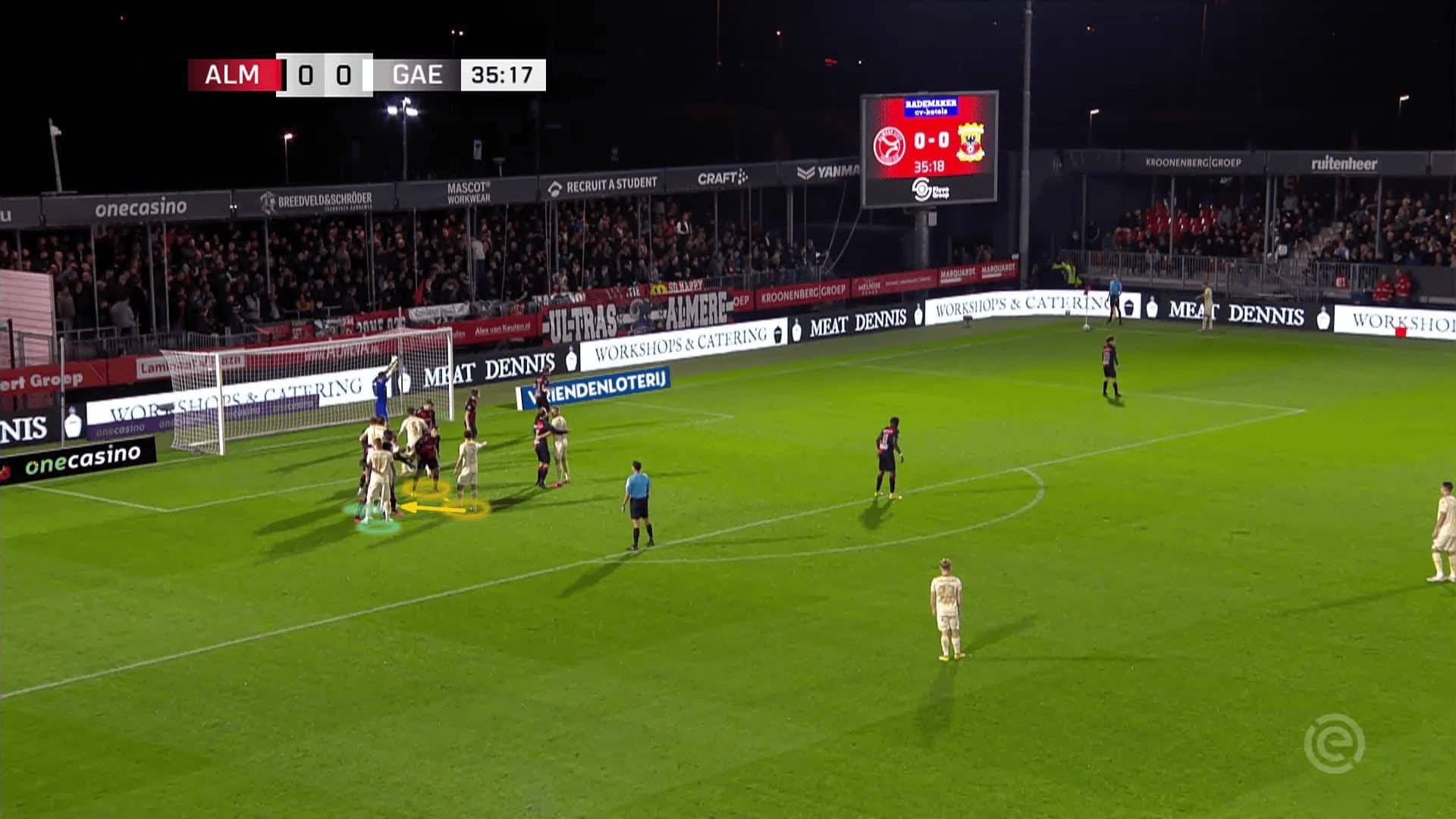
In the photo below, we can see the two parts mentioned above, the red and blue players going towards the two zonal players. In contrast, the yellow player acts as a screen blocking the green player’s marker, but here, the yellow defender realises that trick, so he switches going to the targeted player. Still, this switch gives the targeted player the time to reach before him because the defender comes from long distance, as shown in the two photos below.
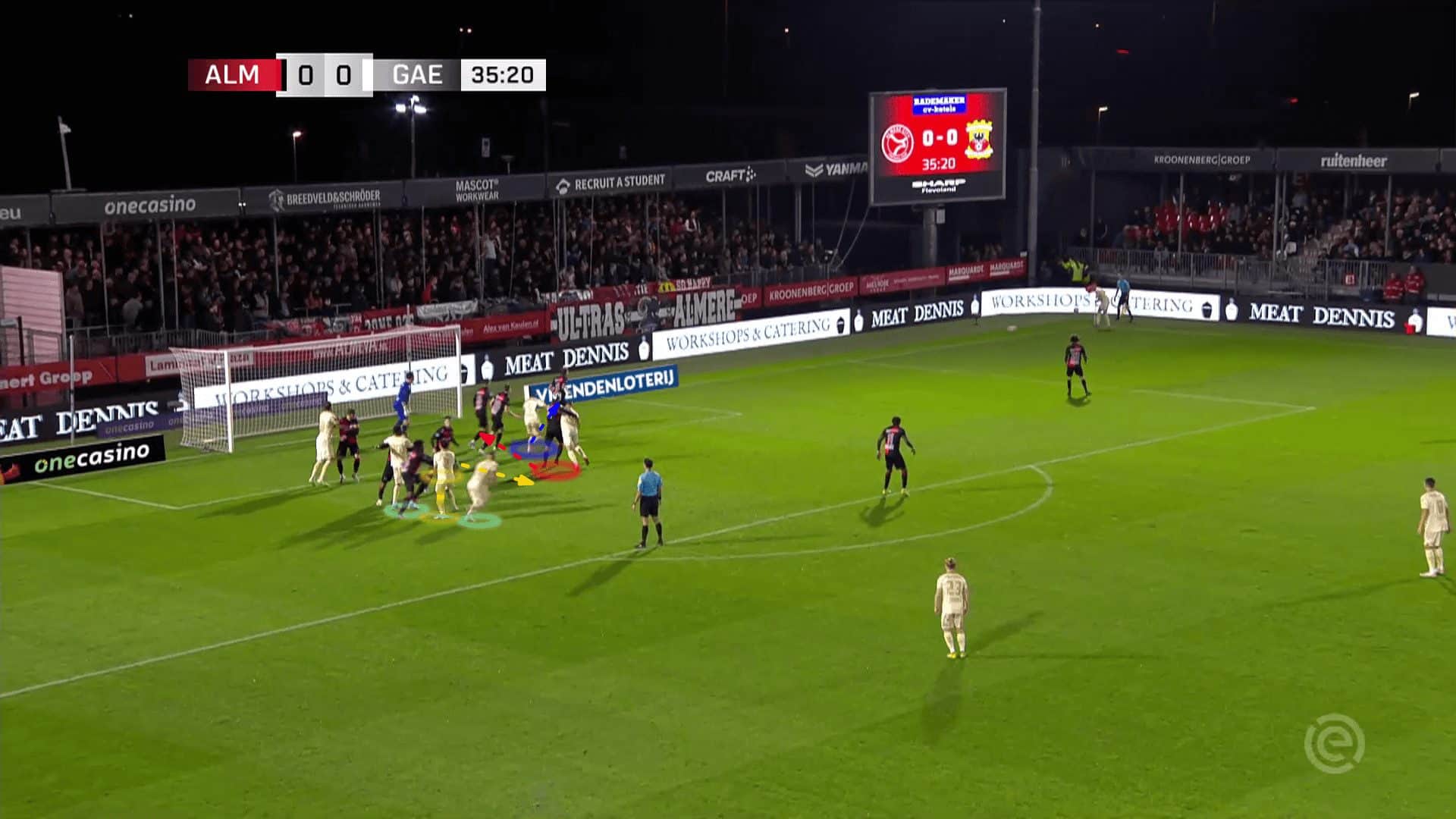
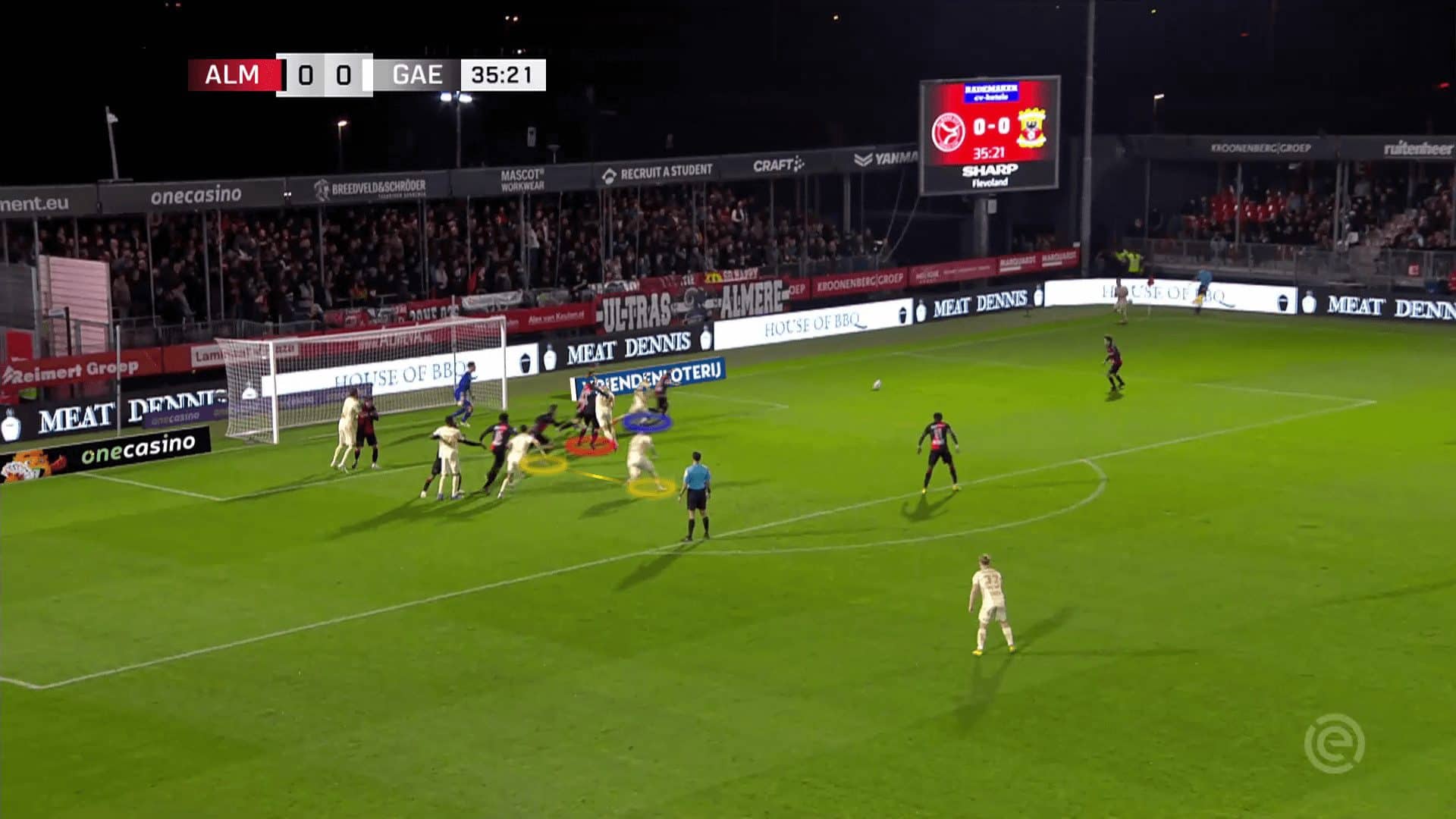
The plan works, so the targeted player shoots the ball from a dangerous area, but the goalkeeper saves it brilliantly, as shown in the two photos below.
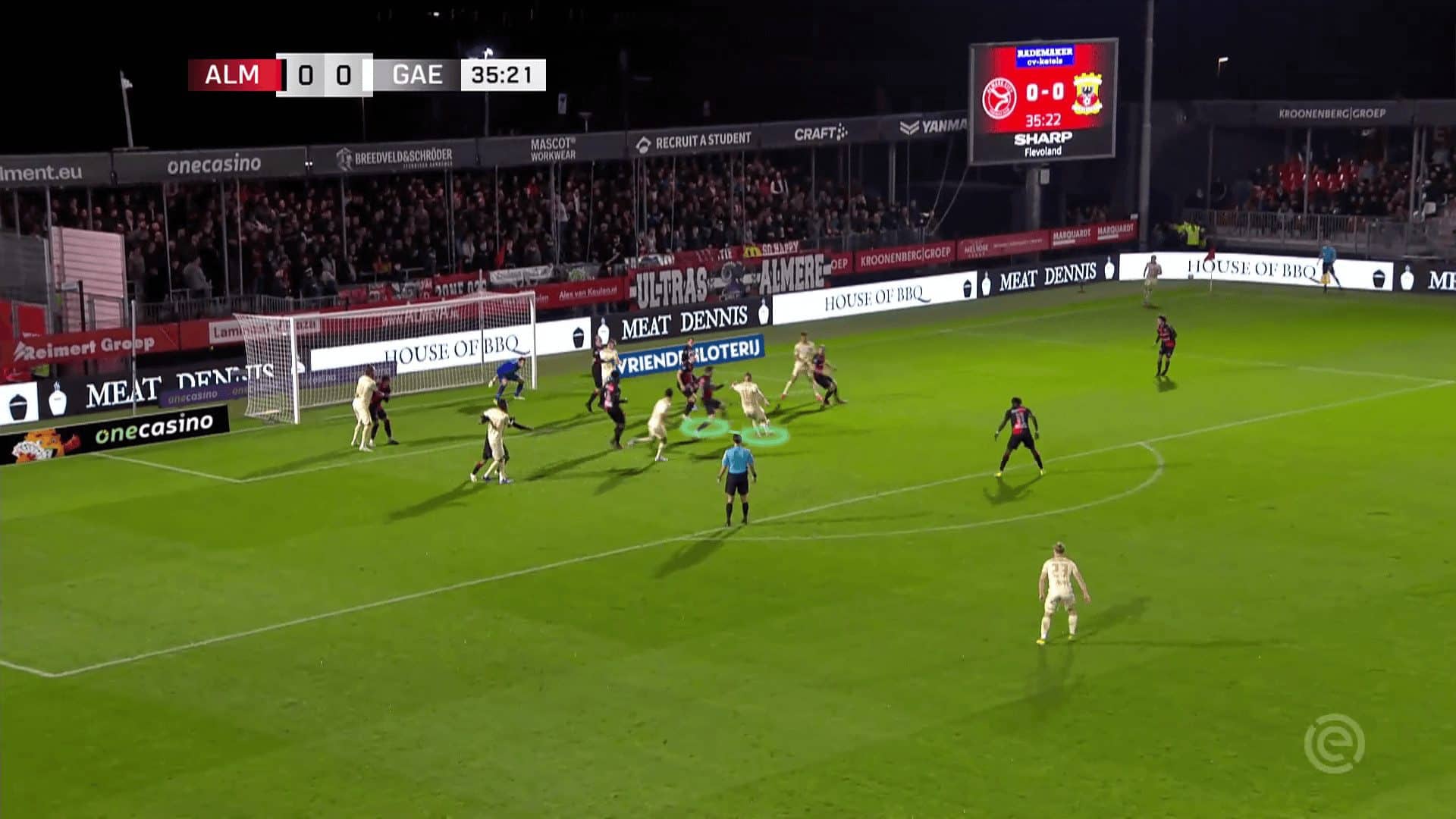
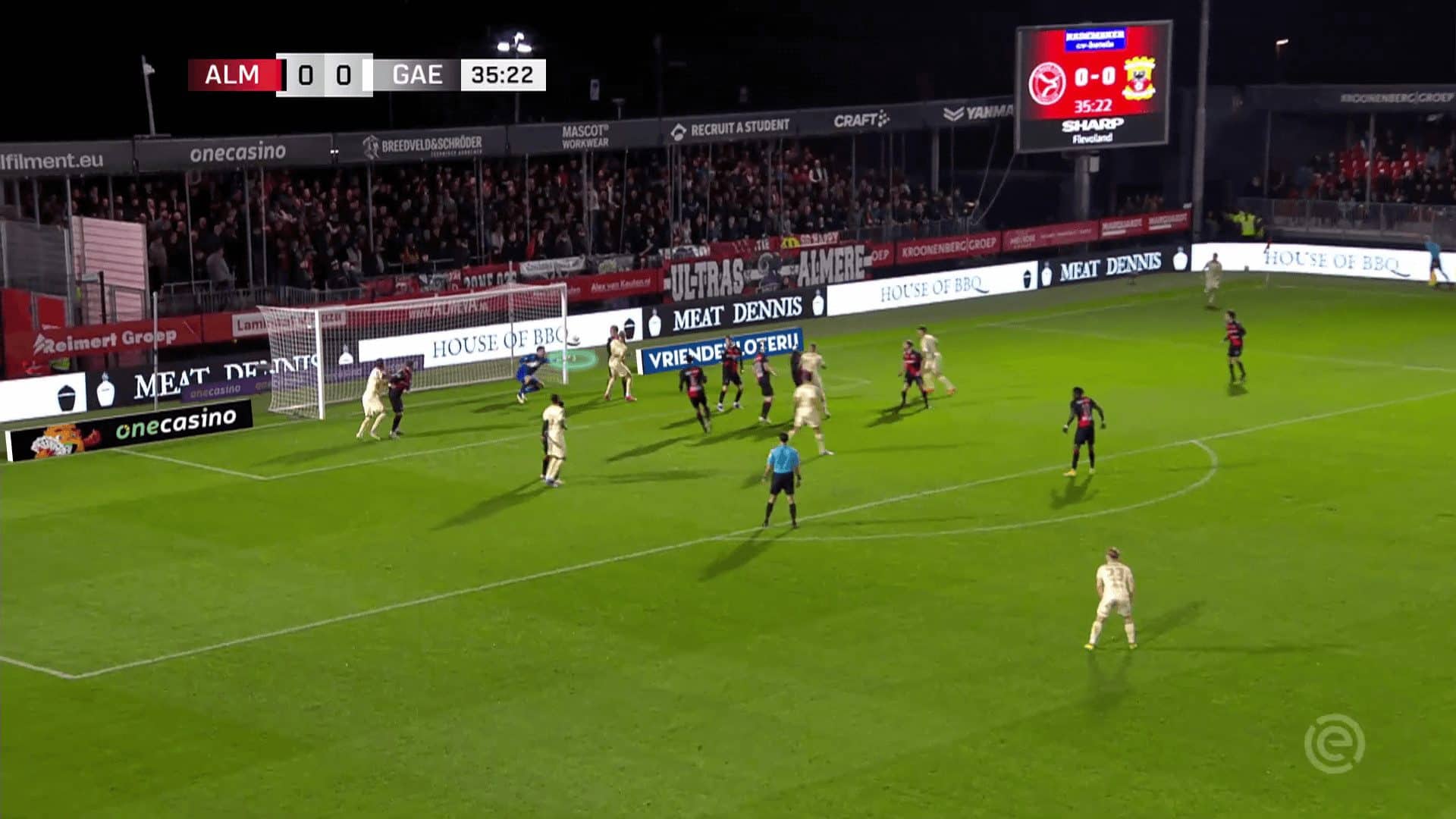
Newcastle United with Eddie Howe have a similar idea below. Luton Town defend with three constant zonal layers: another yellow zonal defender who goes to help in case of short corners, a defender on the edge of the box who has instructions to go to defend the short corner, and the rest are man markers.You can notice below that the last defender focuses on the attacker who drags him away from the assign lane we talk abut.

In the photo below, the yellow and the ink attackers run suddenly towards the taker to drag the two defenders with them, but it is so important to track the five attackers who have man markers assigned to them. The first one goes to the first zonal one to make sure that he won’t go to the ball while the second and third attackers go between the second and the third zonal defenders and behind the third zonal defender while the fourth and fifth ones move away from the goalmouth, so everything becomes ready in the second photo below.
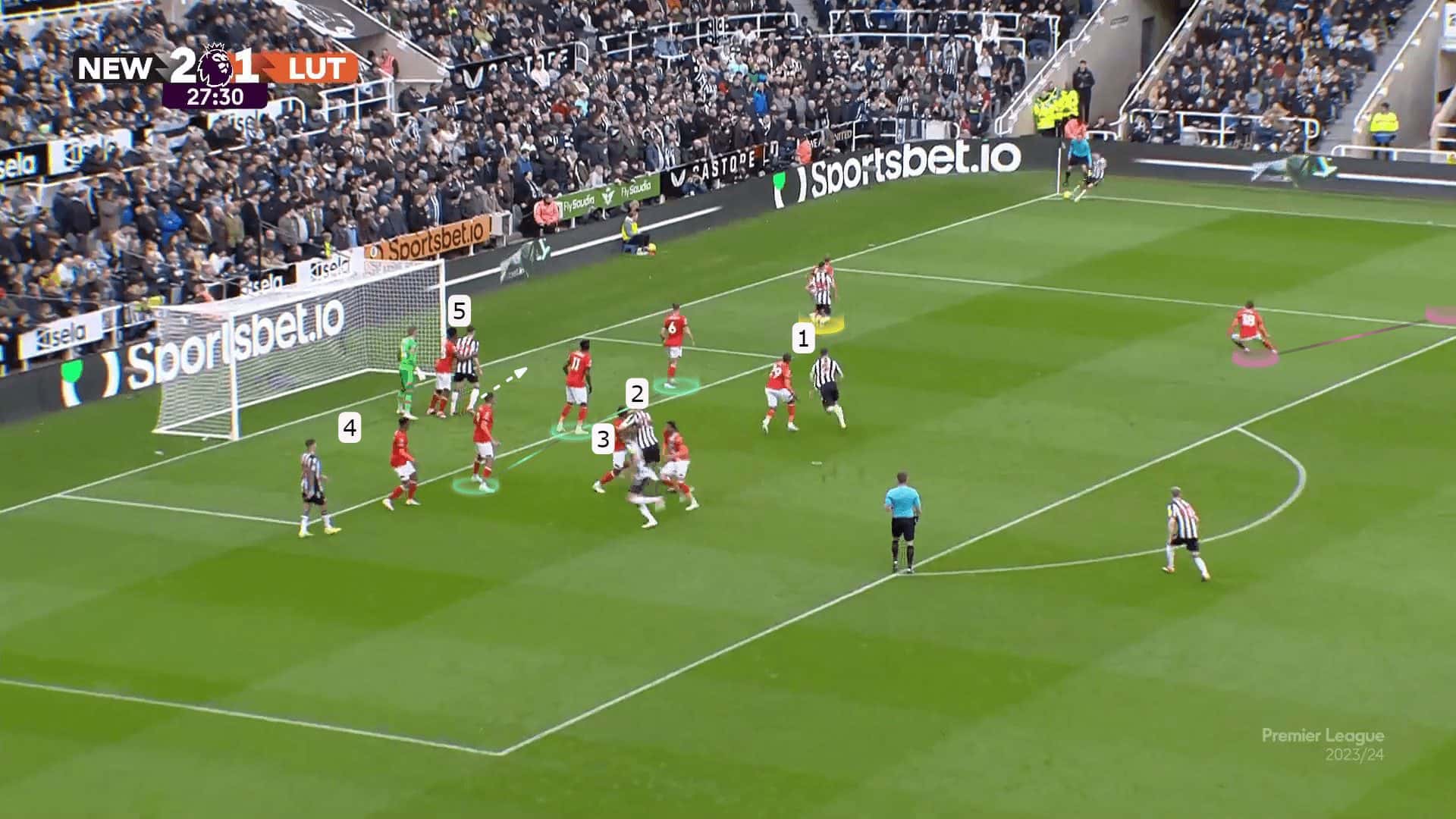
But the short option realises the plan early, so he tries to go back to cut this passing lane.
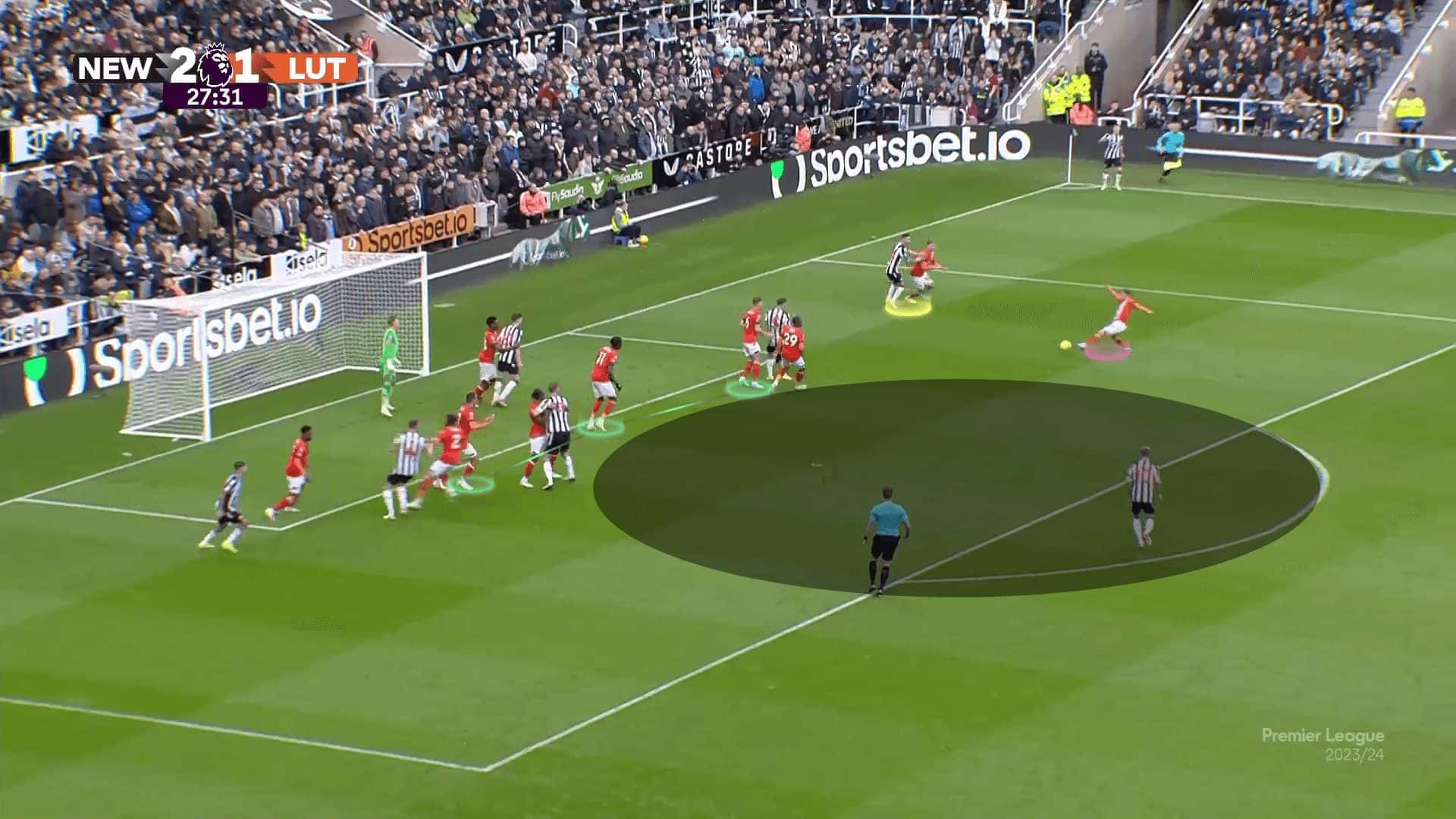
Against hybrid systems
Going to the example, you can find below the defending team defending with a hybrid system, which is a mixture of zonal marking and man-marking defending systems, so you can see five players in the first zonal line, which is declined to the outside because the waited out-swinging cross, but they don’t put a defender on the edge of the six-yard who may obstacle this direct ground pass. In front of them, they use four man markers while a player stands to defend the short corner who is dragged away from this passing and because of the short attacker who stands nearly on the corner of the box.
The attacking team puts four attackers close to each other, while the last attacker is the targeted player who stands behind two attackers to block the last two defenders. In contrast, an attacker blocks the first defender, preventing him from going to the pass, as shown in the two following photos below.
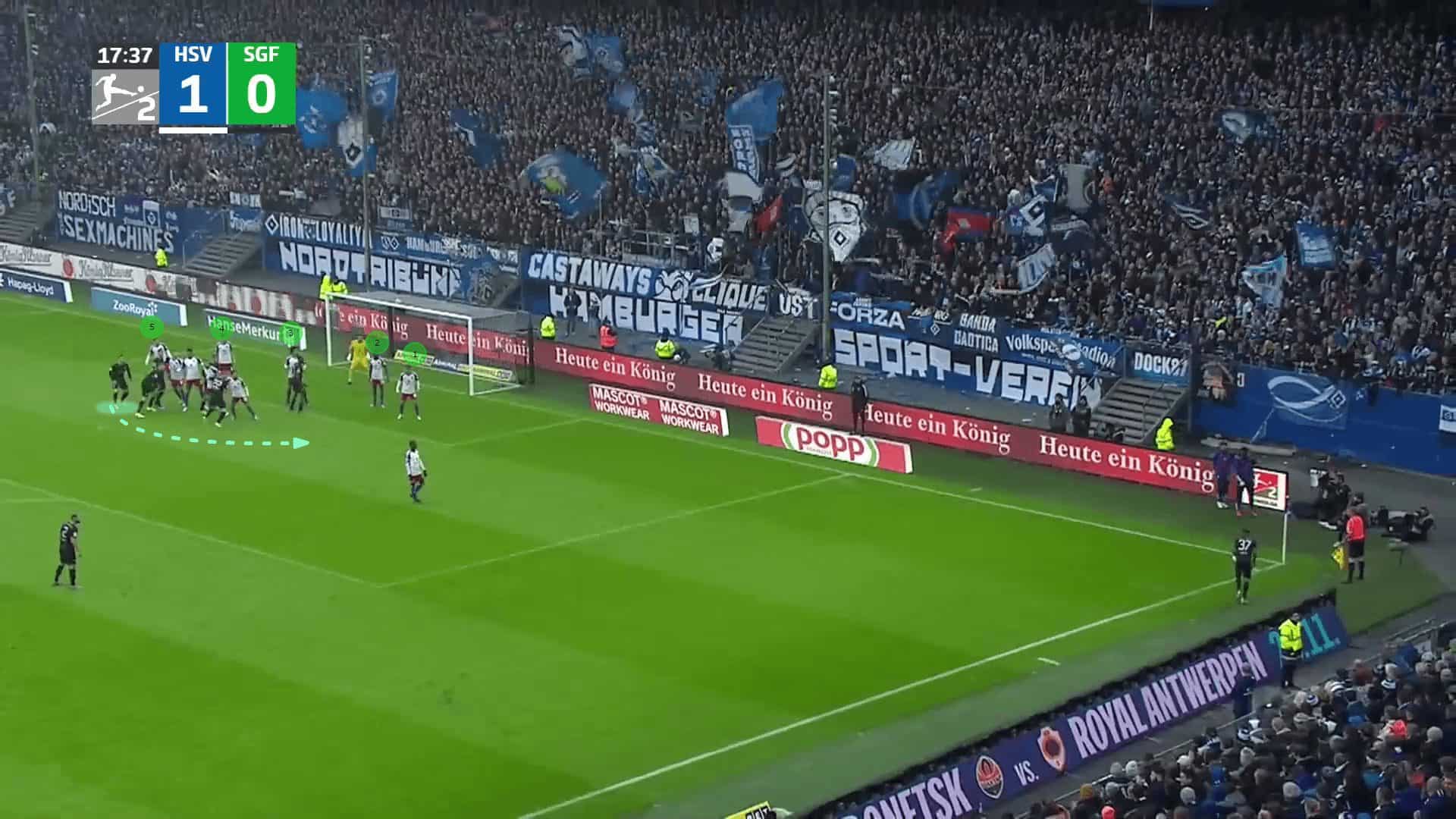
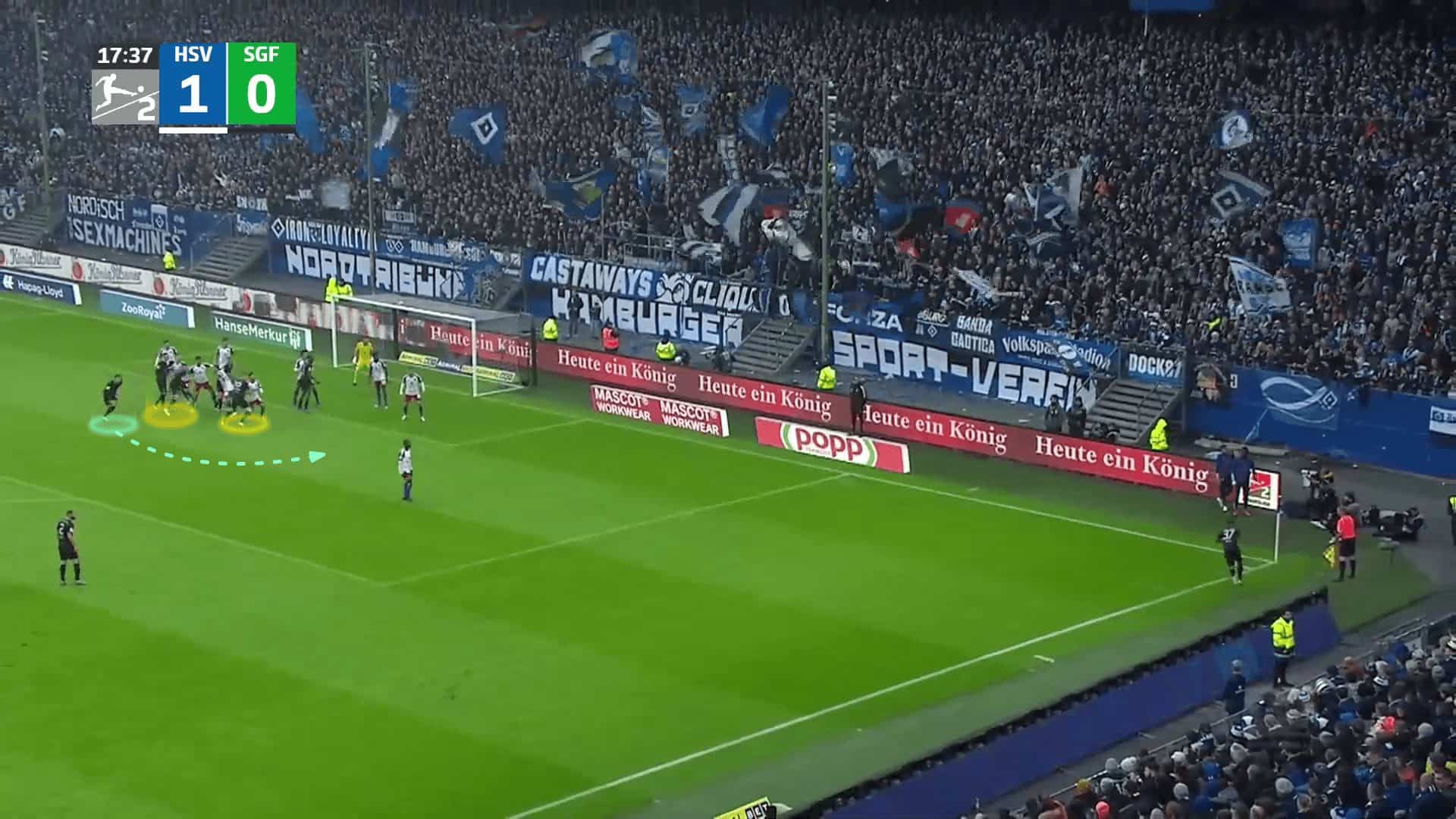
The plan works, but the player can’t control the ball well, as shown below.
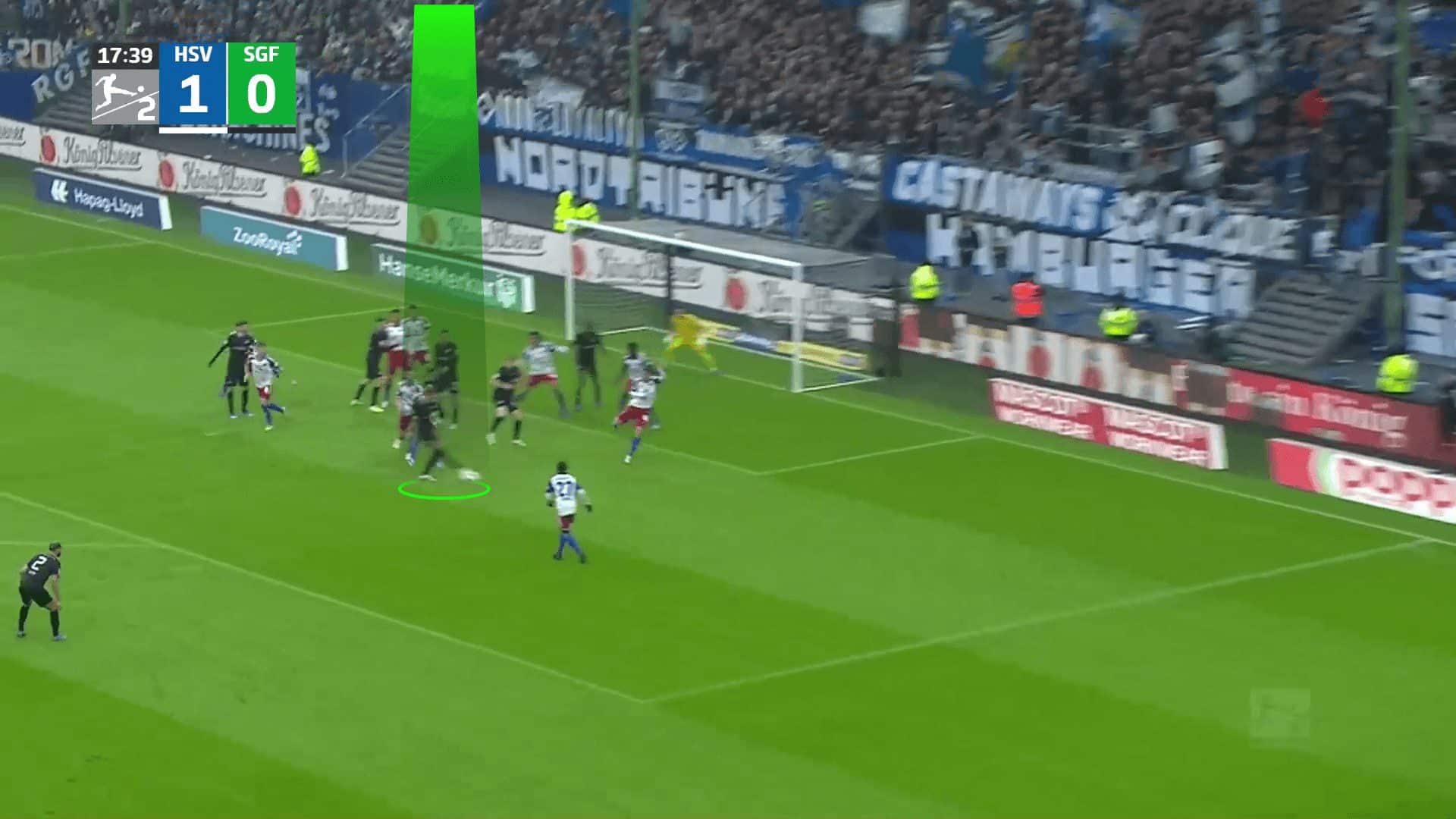
Modified method
Many teams sometimes use a sudden double pass to make the taker closer to the box to make the passing distance smaller, making it too quick for the defender to adapt by going up to cut the ball. In the first photo below, AC Milan defend with a man-marking system with only two zonal defenders, in orange, while a pink short attacker tries to drag the short defender with him away from the flat passing lane. An attacker suddenly goes to receive a short pass, dragging his marker and a zonal defender while the short defender is still fixed, so it is easy for the taker to receive the ball again in a closer position.
In the third photo, it is clear that the passing distance became less while it is also clear that attackers drag their markers away while the yellow targeted player suddenly runs to the back in a curved and unexpected run which makes him earn seconds before his marker who expect to defend towards the goal, not to the back. The mate in black could help the targeted player by blocking his marker, a screen, but because his marker understands the plan deciding to go to cut the ball, he prefers to block his own marker, making the targeted player depend on the seconds he won before his marker.
The plan works, but the targeted player can’t control the ball unluckily, as shown below.
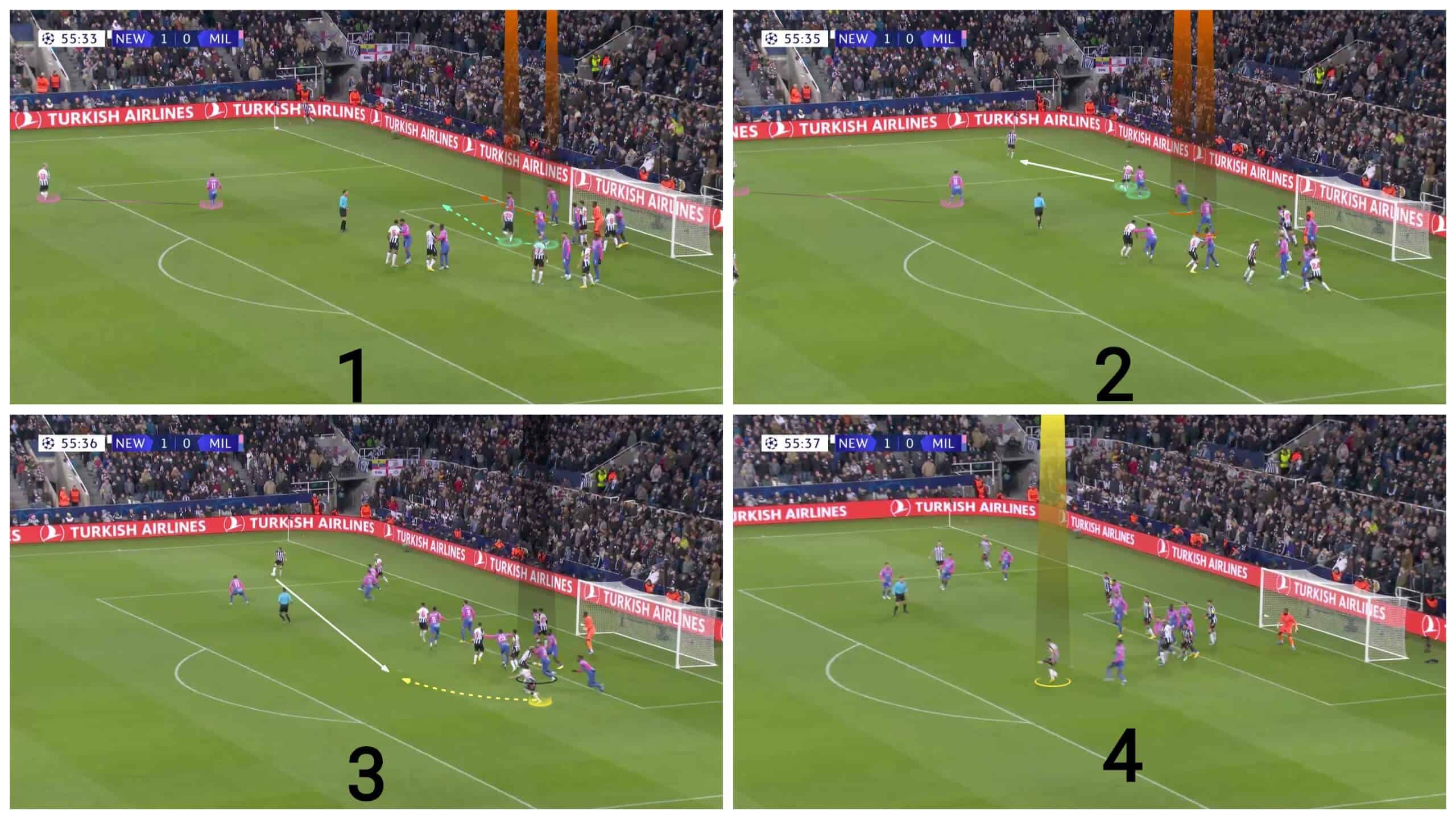
Counter idea
Elite teams easily found a solution, which is asking the short-option defender to stand cutting this flat passing lane at first, and then, he moves to the short-option defender after the pass to make sure that this dangerous flat passing lane is cut.
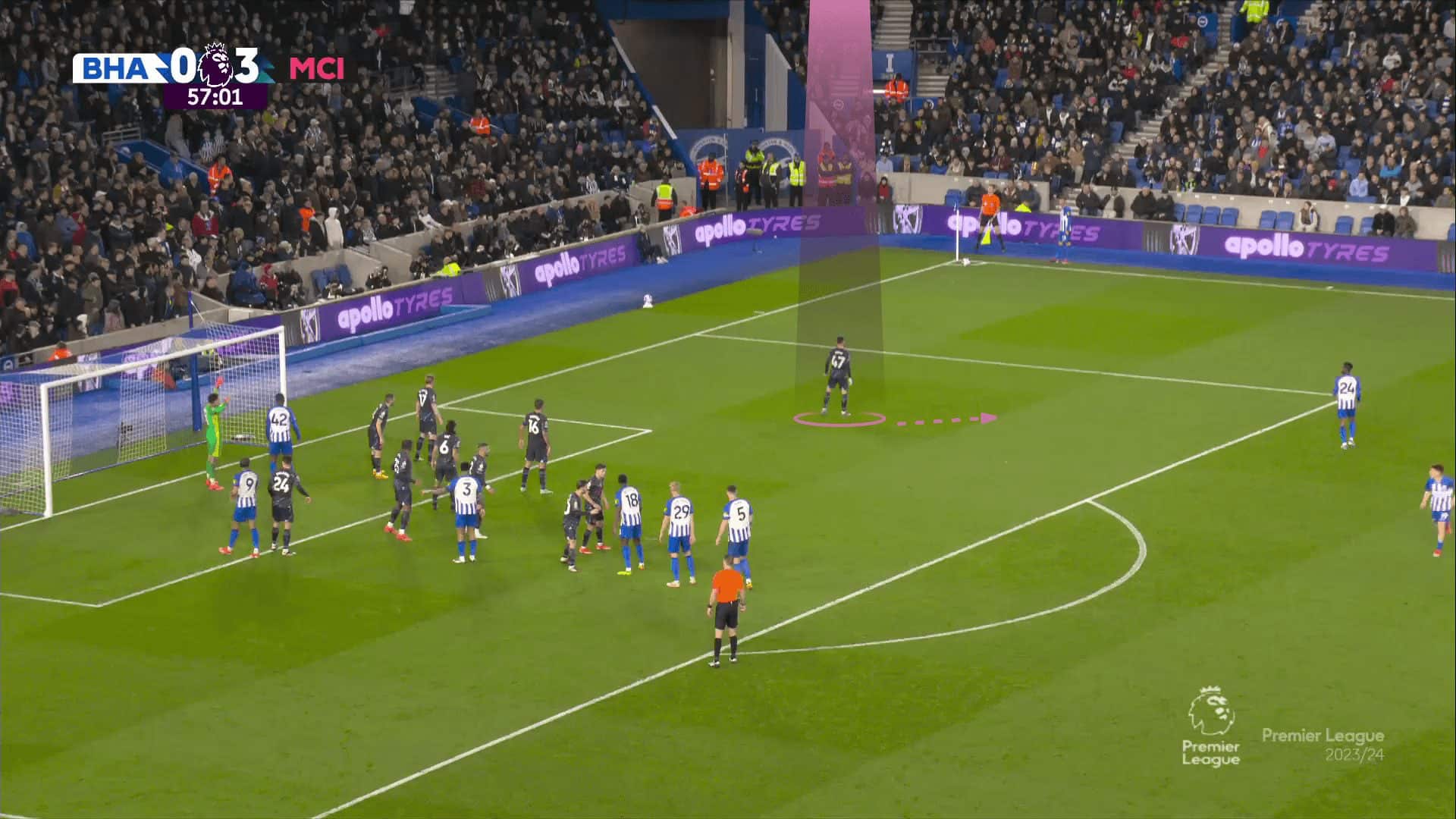
It also happens when the attacking team has no short-option attackers. In this case, the rebound defender starts slightly near the side of the corner to cut this passing lane at first, and then he has the time to defend the rebound after the cross, as shown below.
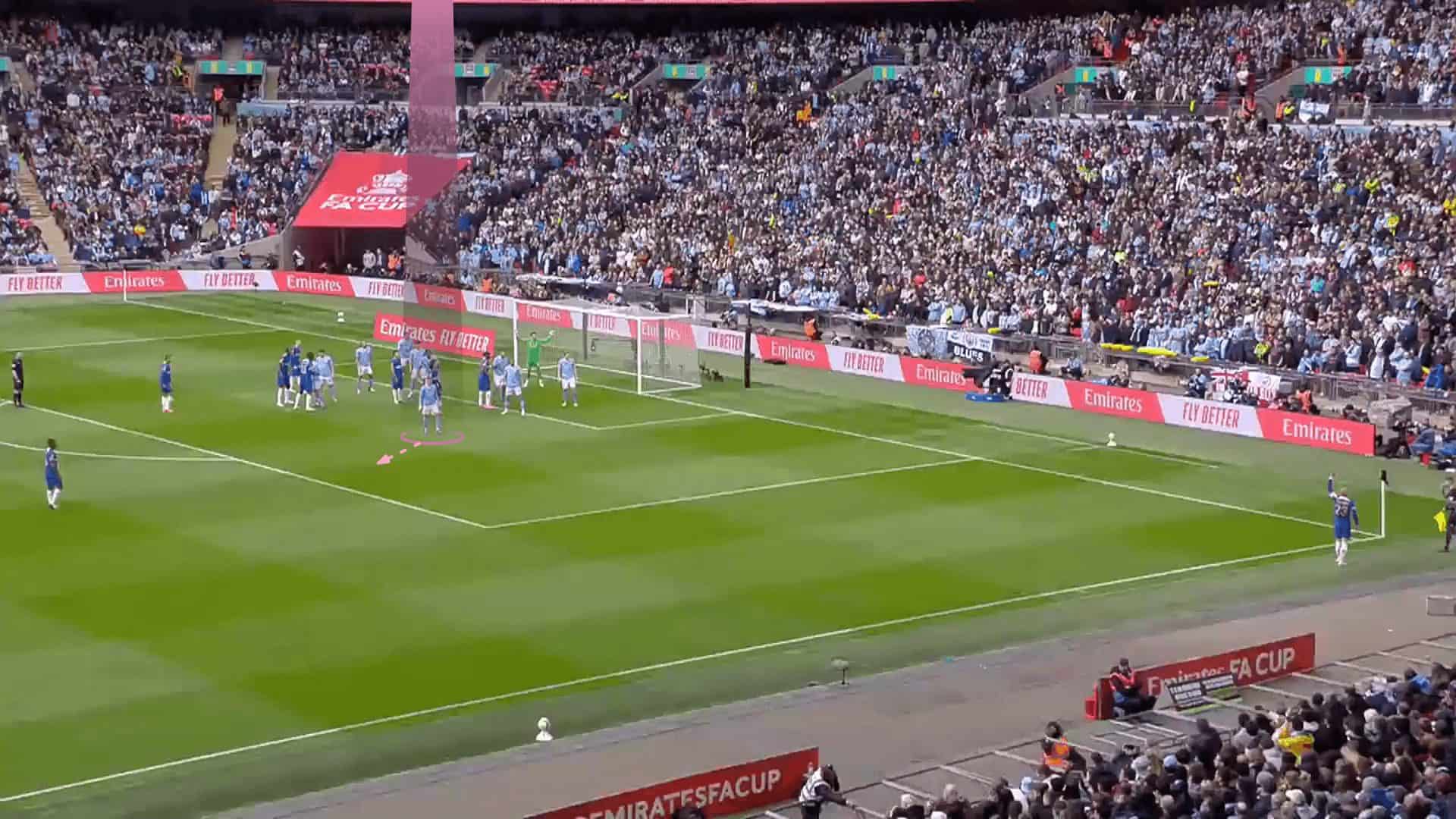
Conclusion
In this analysis, we have shown how coaches and analysts can easily adapt this flat-passing-lane corner routine to target the goal directly by a grounded pass from the taker, only exploiting a small trick.
In this set-piece analysis, we have also explained that this trick is easier than the traditional pass to the rebound zone and we have also clarified that this routine can be implemented against a man-marking defending system or a hybrid system if you can drag the short-option defender away from the passing lane and block the possible defenders that can go to the ball. We have also shown that there are modified ideas to do the same pass. In the end, we have explained the counter, defending, and possible ideas.






Comments